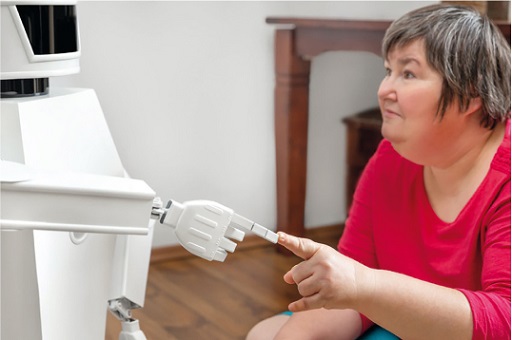1 Digital technology and social care
Going beyond healthcare, there are many different ways in which digital technology has the power to transform both social care and care in the home environment. Across the UK, there is an increasing focus to keep people in their own homes and able to live independently for as long as possible, which corresponds to growing concerns regarding treating and keeping people (particularly older people) in hospitals when they don’t need to be there. In fact, being in a hospital when someone is very old or has signs of frailty can present a risk to their health, so we have a duty to think about the most safe and appropriate places to care for people.
Home care (domicillary care) can be provided by social care services in a person’s home environment. It may include assistance with washing and dressing oneself as well as preparing meals. For example, people with disabilities or people who are recovering from hospital treatment or dealing with illness may require assistance with some of these tasks. Predictions about the future of home care needs show that we can expect major increases in the number of people who need social care services for home care (Wittenberg and Hu, 2015) and that there has been an interest in the way that technology can help cater for the growing needs and future demands for social care and caring in the home environment (Bennett et al., 2018). However, home care has a role in supporting people to regain physical, emotional and social skills and so we might wonder how technology can support people in this – this is an important question to keep asking ourselves as we increasingly adopt technology in the home care environment.

In the following activity, you will read a news article on how technology can change and improve social care.
Activity 1 Weighing up the news
The news article, ‘Can technology fix the social care crisis?’ [Tip: hold Ctrl and click a link to open it in a new tab. (Hide tip)] , reports on why technology is being introduced to transform social care. Read the article and make notes in the text box below about the key pros and cons of transforming social care with technology.
Discussion
Here are some pros and cons you may have considered, along with a summary of what you have learned by doing this activity.
Pros
- Technology in social care may save money and the social care sector is under financial strain.
- The NHS Digital programme has money attached to it and so presents an opportunity to use some of these resources for the social care sector.
- Technology may make communication between individuals more streamlined.
- There may be improved record keeping or record management.
- Technology may allow individuals to receive home-based care.
Cons
- The article suggests that the care sector is behind the times when it comes to incorporating technology so far.
As you can see from the notes you made for your pros and cons list, the article suggests that there are a lot of benefits to incorporating technology in social care but is very scant on the challenges and risks of doing so. This article presents a somewhat simplistic and biased view of technology enhanced care and shows that by looking at the key messages described in the news, we can gain a better understanding of how in-depth and balanced the news article is. It is important to note that even though this article is presented as news, the writers may be supportive of a particular view and may be pushing an agenda in their article. You may have been surprised by how these developments are being presented as an opportunity for money-making and business as this might conflict with our traditional notions of the importance of quality and personal care that is offered for free at the point of use. This is an interesting tension in incorporating technology and digital services in health and social care. Hopefully, this activity will encourage you to see how you can identify bias and think critically when reading the news.
There are many opportunities that come with incorporating technology with care, but you may be able to think of problems as well. With that in mind, it is important to be able to weigh up the benefits and risks to ensure that any decisions regarding the use of technology in care do not go on to discriminate or present poor or inequitable care for people based on their access to and understanding of technology.
